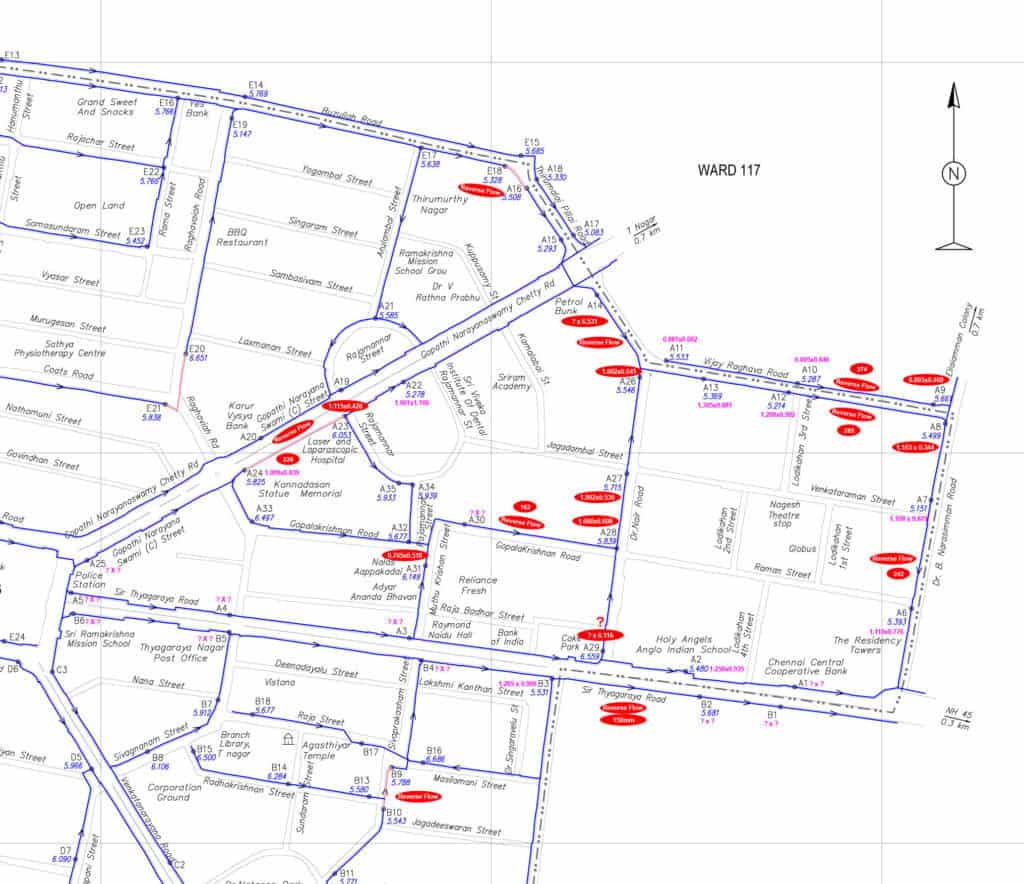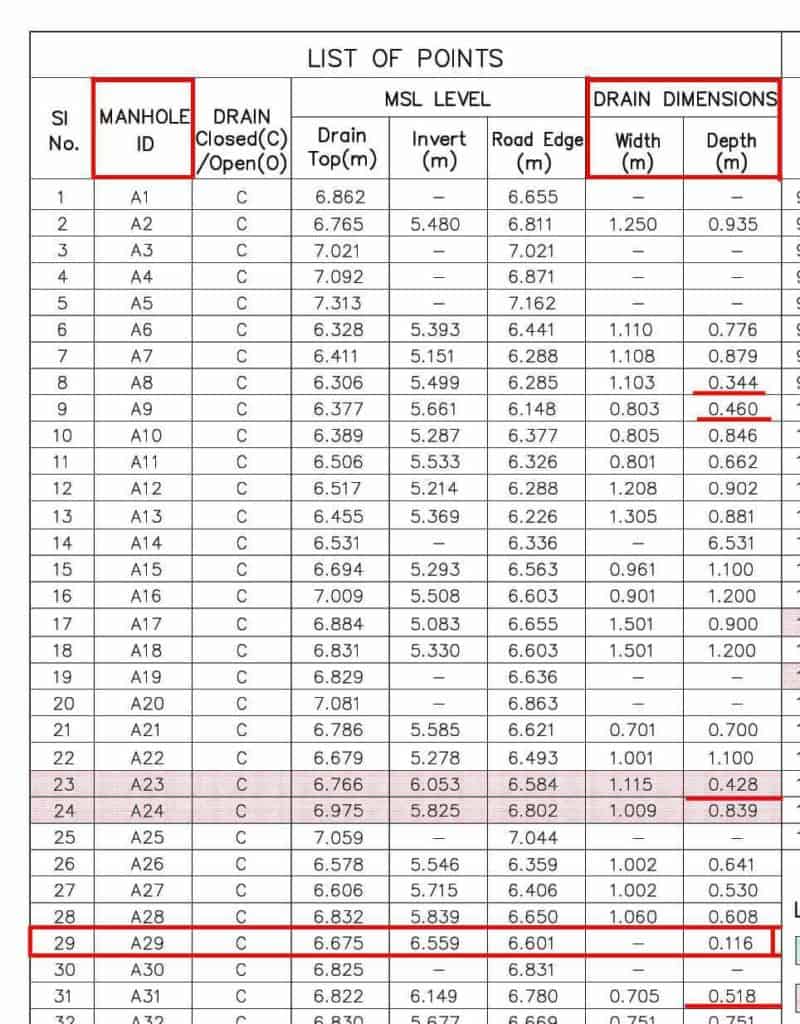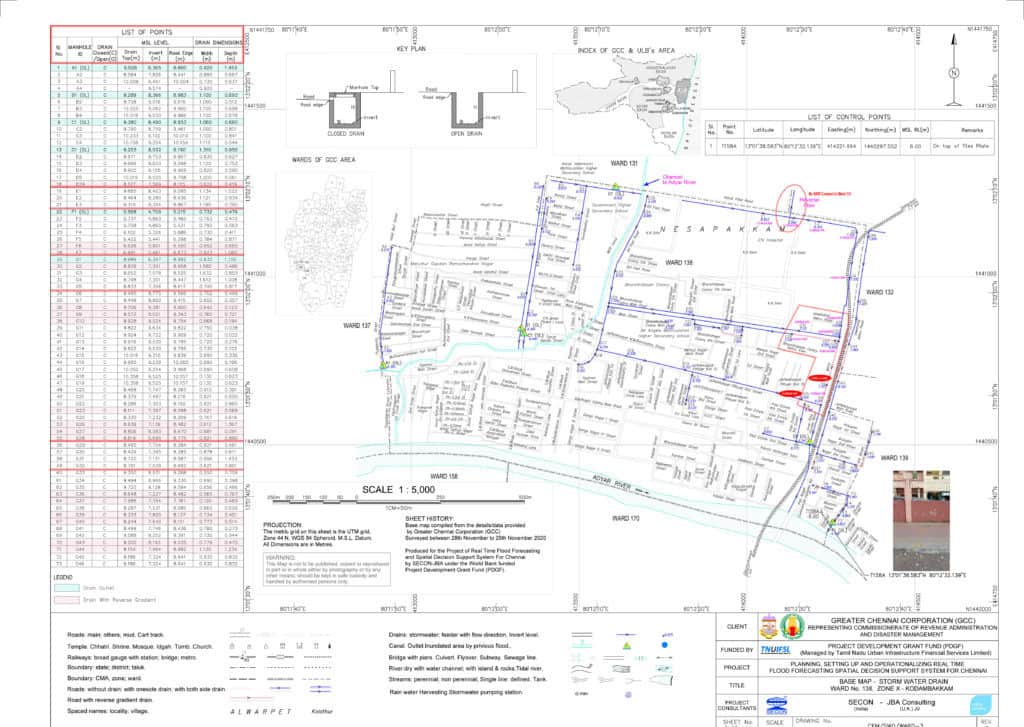The recent spell of rains in Chennai saw large-scale inundation across the city. Visuals of residents wading in knee-deep water dominated the news. Many residents saw water enter their homes and found their belongings destroyed. Anguish and anger poured out on social media posts of those who went through this harrowing experience. And all along came questions about the city’s many stormwater drains and why they failed to serve the purpose.
Are the questions being asked of the stormwater drain project in the city legitimate? Could design flaws in the stormwater drains be a contributing factor to wide-spread water stagnation?
What is the issue with stormwater drains?
Stormwater drains are a network of pipes that collect run-off rainwater from ground surfaces and carry them to catchment areas such as lakes, ponds and rivers. If designed well, these can prevent flooding and waterlogging in the streets. Water moves through the network of underground pipes in to the larger catchment areas. Naturally, the pipes are to be designed taking into account various factors such as the land terrain, the slope of the land and the quantum of rainfall received. But basic design flaws are a major issue with the stormwater drains in Chennai and that does not allow uninterrupted flow of water.
In the construction of stormwater drains, a key preliminary process that should be carried out is a contour study. This can help the civic body plan the specifications of the drains by taking into account the mean sea levels and the natural channels by which the water traverses the area.
The absence of a contour study means that there is a total lack of understanding of the topography of the terrain, absence of information on flow of water to low lying areas, lack of rainfall catchment study and its connection to natural waterways.
The Chennai Corporation recently released maps of the stormwater drains in the city. On close observation of the maps in a few areas, it is shocking to find blunders like gradient issues, reverse flows and inadequate drain size in the stormwater drains.
Read more: Flooding in T Nagar raises a lot of questions for the smart city mission
Observations on stormwater drains of Ashok Nagar
Both Ashok Nagar and T Nagar saw severe flooding during the rains earlier this month. Even after the rains abated, the waterlogging in the streets persisted for days. Civic authorities used pumps and tankers to remove the water from some of the roads. This process went on for days. This has greatly distressed the residents of the areas.
Simple observations during a field visit to both localities revealed large scale lapses in construction of the stormwater drains here. This played a key role in waterlogging in the streets of both the localities.
Looking at the areas in and around Ashok Pillar, it was observed that the low-lying contour falls at CPWD Quarters and all rainwater reaches this point which is 9m above mean sea level with surrounding areas at 10m or 11m above mean sea level. Hence this section sees severe inundation.
The interesting fact is that merely 320 metres from here, there is a rainwater channel in the west direction, running along PT Rajan Salai. The channel crosses Ashok Pillar Road and Venkatraman Salai leading up to the Adyar River at 3m above mean sea level. It runs for a length of 1.7 km. But the key stormwater drains in the area have not been connected to this natural channel.
This lack of linkage is one of the reasons why waterlogging was seen in a low-lying areas. If stormwater drains of adequate size were to be constructed based on rainfall catchment quantification and connected with natural waterways or channels, this would really mitigate flooding.
Stormwater drains E1,E2,E3 in Ashoka Pillar Road in Depot 138 map are left disconnected halfway to the opposite side of Kamarajar Salai. Drain size is seen to be varying from manhole to manhole.

Moreover the drain sizes at manholes G4, G3 are of bigger width around 1.6m but at the further downstream manhole G32 the width reduces to 0.62. At this junction, the rainwater flow from Bharathidasan Street adds more water quantity. This shows a basic flaw which is the sudden reduction in carrying capacity of rainwater. Manhole G9 has a reverse gradient 0.982 metres (i.e. 3.25 feet) which also adds severity to the inundation. This will definitely result in inundation upstream.
Issues present in T Nagar
In T Nagar, there are gradient flaws, reverse flows and inadequate size of stormwater drains.
On observing the maps released by the Chennai Corporation, one finds that the drain size is too small for roads such as Dr Nair Road and Thyagaraya Road in Ward 136. When the drains were surveyed between January 25th to 28th this year, the depth of Drain A29 was found to be only 0.116 m or 4.5 inches. This makes it too narrow and small to carry even the quantum of rainfall that these roads receive during a normal spell of rains, let alone historic levels of rain such as we just witnessed.


Read more: Chennai rains: The real reasons why urban floods are a never-ending problem in city
How can these stormwater drains be rectified?
In order to implement real flood mitigation measures, it is important that a proper contour and rainfall catchment quantification study is carried out across the city. The next step is to try to connect the stormwater drains to natural waterways, wherever possible. Inundation maps and gradient study should be done to get the best understanding of terrain and flooding across all localities, especially those in low-lying areas. On-boarding subject matter experts is crucial to get the flaws remedied and prevent future flooding.
It is unclear why crores and crores have been spent on such projects without taking some of these basic parameters into account. Any future planning and construction of stormwater drains must have a minimum requirement of contour study and understanding of the topography and natural channels available nearby. A more advanced version of planning would be to construct 3D models to understand the levels of inundation possible in each area.
In the absence of natural channels, the design must be perfected to ensure that the water traverses comfortably. In low-lying areas, pump systems can be installed permanently to ensure quick drainage of water.
Not allowing houses to be constructed abutting these natural channels is a step that can be taken going forward. There are mandates in states like Andhra Pradesh and Telangana (GONo.168 dated 09.04.2012) to have gaps from the defined boundary of the canal for any construction. If the canal width is more than 10 metres, the gap should be 9 metres from its defined boundary. If the canal width is 10 metres or less, a gap of 2 metres must be left from its boundary for any construction.
In the absence of natural channels or in case of encroachment or construction on these channels, artificial channels can be created to allow for the flow of water. A parallel alignment with what would have been the natural channel can be considered for this. This will ensure end-to-end connection between water bodies nearby.
All of this must be done along with active consultation and involvement of all residents and stakeholders in the area. The public too must take an interest in the process. Their voices being heard on such issues can prevent such future events.
Chennai is facing the worst ever experienced flooding causing tremendous hardship to the people. It’s hightime to think of different strategy instead relying on age old watercarrying and draining system which is unable to cope up with the unexpected downpour of rains due to global warming phenomina. Big metro cities like chennai how they are trying to manage the transportation problem by different methods of transport like metro rail, elevated road system ringroads etc. the planning bodies have to give serious thought to bring additional water disposing channels which can carry huge amount of water linked with storm water drains at every part of city which should also can be linked to the existing river basins passing through the city and by which smoothflow of water can be ensured. With the help of experienced and technical expertise availabe with the authorities evolve an homogeneous solution so that we can avoid the grave situation arising out of heavy downpour during monsoon seasons with cyclonic wheather. Better think fast and implement at the earliest.
Forget about a Smart City ,let us first have a Safe City!
It is all corruption and commission that has spoiled the metrowater network.Huge amounts are shown as spending for upgradation but actually they are going in to the pockets of the concerned. God only can save Tamilnadu.
Article above us well analysed and presented. As a resident of Ashok Nagar, could visualise what is said here. Absolutely suffering with water not receding after several days. Shows the calibre and quality of the engineers we have, who are not concerned with society. So frustrating that you can call these so called designers/engineers, Govt, etc reckless and corrupt. No permanent solution for people and they are left to defend themselves. Sorry state of affairs . Thanks
I do agree with Mr.D Krishnan article. As mentioned, contour (natural graduant) studies becomes mandatory to avoid inundation during heavy down pour. Coastal City like Chennai periodically affects during monsoons. Hence, the following studies becomes essential as control and corrective measures.
1. Detailed contour map of the greater Chennai
2. Demarcation of low-lying areas
Removal of encroachment along the natural course of the existing rivers systems
3. Interlinking of existing water bodies located in and around Chennai city
4. Optimum utilisation of the existing Buckingham canal situated along the east coast
5. Riverse water conducting system towards u/s side
6. Establishment of Permanant pumping system
7.Optimum utilisation of the existing experts including retired from the reputed Organisations both from Central and state Govt.
8. Available resource and latest updated technology for preparation of bankable DPR
9. Detailed studies on Geology, Geotechnical and water resource management becomes need of the hour
10. Constitution of expert team for permanent solution to avoid inundation at Chennai
Regards
Diagonally opposite K-4 police station at the junction of 3rd avenue and 6th avenue. The smallest rains flood this corner for the simple reason that for about 50 mtr, there are no entry points into the swd.
Above all carry bags and pet bottles have chocked all the drainage which is the main reason for flooding of streets which cannot be denied.
All these observational studies only to dictate, indicate and facilitate more digging around the drainage more and more and incidental expenditure for GCC and contractors merry days ahead. We should really be ashamed of our intelligence and instead use AI, block chain technology and data analytics. Concrete solutions would emerge rather laying once again cement and mortar.
Storm water concrete slabs very very heavy/very long in our streets difficult to remove/handle during cleaning operations. Only crane/JCB required to open the concrete slabs.
It’s all a result of dirty politics and seat concerned politicians and employee..who r aware of fund …but not the city ….it’s a every year story to chennai….
Where is this map available